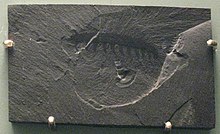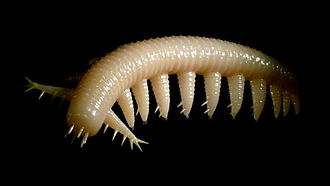Aysheaia
| Aysheaia Temporal range:
| |
|---|---|

| |
| Aysheaia specimen number USNM 365608 | |
| Scientific classification | |
| Domain: | Eukaryota |
| Kingdom: | Animalia |
| (unranked): | Panarthropoda |
| Phylum: | †"Lobopodia" |
| Class: | †Xenusia |
| Order: | † Protonychophora
|
| Family: | †Aysheaiidae Walcott, 1911 |
| Genus: | †Aysheaia Walcott, 1911 |
| Species: | †A. pedunculata
|
| Binomial name | |
| †Aysheaia pedunculata Walcott, 1911
| |
Aysheaia is an extinct genus of
of British Columbia, CanadaAnatomy
Aysheaia has ten body segments, each of which has a pair of spiked, annulate legs. The animal is segmented, and looks somewhat like a bloated caterpillar with a few spines added on — including six finger-like projections around the mouth and two grasping limbs on the "head". Each leg has a subterminal row of about six curved claws.[1] No jaw apparatus is evident.[2] A pair of legs marks the posterior end of the body, unlike in onychophorans where the anus projects posteriad; this may be an adaptation to the terrestrial habit.[2][3]
Ecology
Some specimens of Aysheaia have been found associated with sponges, though this does not provide direct evidence of diet.[4]
Affinity
Aysheaia is a
Distribution
Aysheaia is known from
History of research

Description by Walcott (1911)
Aysheaia was described by Walcott in his 1911 work on annelid worms; Walcott imagined that a head (not observed) was present to support a polychaete affinity.[1] His attention was soon drawn to the organism's resemblance to velvet worms,[1] which was supported by other early researchers (1920s-30s) who also recognized a similarity with the onychophora,[8] although because Aysheaia does not fall within the range of living onychophora, it has also been allocated to a phylum of its own.[9] Nevertheless, an Onychophoran affinity represented the common opinion until the fossil was redescribed in the late 1970s.[2]
Major redescription by Whittington, 1978
In the 1970s, Whittington undertook a thorough redescription,
Response to Whittington (1980s)
The response to Whittington's redescription can be loosely classed into three camps: one school, predominantly Bergström, downplayed the similarities to the Onychophora and focussed on the Tardigrade interpretation; whereas others (after Simonetta and Delle Cave) recognized a group of lobopods containing Onychophora, Tardigrada, and Aysheaia (with features of both).[2][3] Robison preferred to interpret Onychophora as the sister group to Arthropoda, and placed Aysheaia in the Onychophoran stem group in a taxon called Protonychophora (solely containing Aysheaia). These were differentiated from Euonychophora (the crown group) by the number of lobopod legs and claws, the unusual head appendages, the absence of eyes, jaws, antennae and slime glands, the morphology of the rear of the body, and the terminal mouth.[2]
Modern era

Later work uncovered further material of Xenusion and relatives, particularly from the Chinese fossil deposits. In light of the cladistic revolution of the 1990s, Aysheaia and its relatives were recognized as early offshoots of the lineage leading to arthropods and onychophorans.
Looking from the opposite direction, Budd points out that there are no characters that exclude Aysheaia from the Arthropoda.[12] It may be premature to assign Aysheaia to the Onychophora over Arthropoda, as it lacks any distinctive features of the onychophoran crown group; rather, both Onychophora and Arthropoda may have arisen from animals resembling Aysheaia and its kin.[13] Budd sees Aysheaia-like organisms as representing a paraphyletic grade from which both modern onychophoran and arthropods evolved.[12][14]
Etymology
The genus name commemorates a mountain peak named "Ayesha" due north of the
See also
References
- ^ JSTOR 2418243.
- ^ JSTOR 1304837.
- ^ a b c
Malcolm S. Gordon, Everett C. Olson (1994). Invasions of the Land. The Transitions of Organisms from Aquatic to Terrestrial Life. Columbia University Press. pp. 103–104. ISBN 9780231514026. Retrieved 2022-08-21.
- S2CID 4399940.
- ISBN 9780471042907.
- S2CID 53646959.
- .
- ^ * BRUES, C. T. 1923. The geographical distribution of the Onychophora. American Naturalist, 57: 210-217.
- WALTON, L. B. 1927. The polychaete ancestry of the insects. American Naturalist, 61: 226-250.
- HUTCHINSON, G. E. 1930. Restudy of some Burgess Shale fossils. Proceedings of the United States National Museum, 78(11): 59.
- WALCOTT, C. D. 1931. Addenda to descriptions of Burgess Shale fossils. Smithsonian Miscellaneous Collections, 85(3): 1-46.
- S2CID 84284702.
- ^ DELLE CAVE, L. AND A. M. SIMONETTA. 1975. Notes on the morphology and taxonomic position of Aysheaia (Onycophora?) and of Skania (undetermined phylum). Monitore Zoologico Italiano, 9: 67-81.
- ^ TIEGS, O. W. AND S. M. MANTON. 1958. The evolution of the Arthropoda. Biological Reviews, 33(3): 255-333.
- ^ ISSN 0044-5231.
- S2CID 2567113.
- S2CID 37935884.
- British Columbia Geographical Names Information System. Archivedfrom the original on 2011-07-06. Retrieved 2010-05-17.
Further reading
- Whittington, H. B. (16 November 1978). "The Lobopod animal Aysheaia pedunculata Walcott, Middle Cambrian, Burgess Shale, British Columbia". JSTOR 2418243.
- Robison, R. A. (1985). "Affinities of Aysheaia (Onychophora), with Description of a New Cambrian Species". Journal of Paleontology. 59 (1). Paleontological Society: 226–235. JSTOR 1304837.
External links
- "Aysheaia pedunculata". Burgess Shale Fossil Gallery. Virtual Museum of Canada. 2011. Archived from the original on 2020-11-12. Retrieved 2023-01-21.
- Smithsonian Institution image
- Lobopods from the Cambrian of Utah


